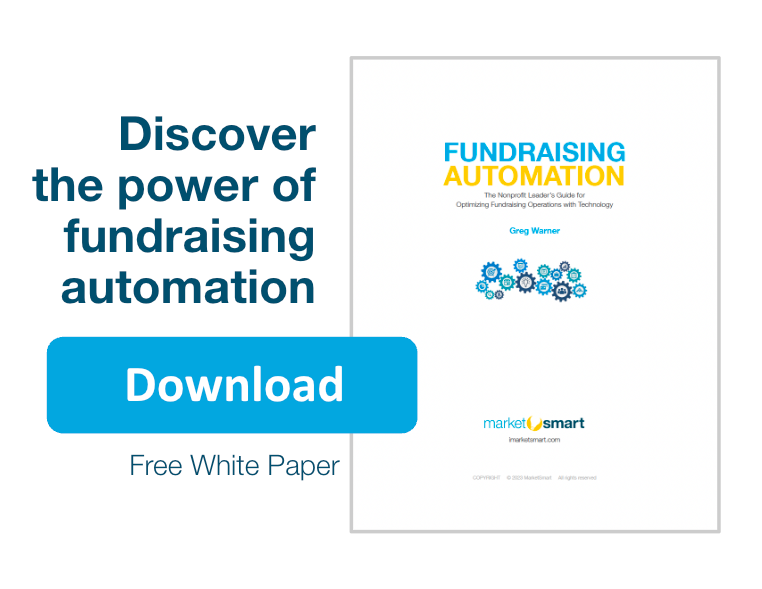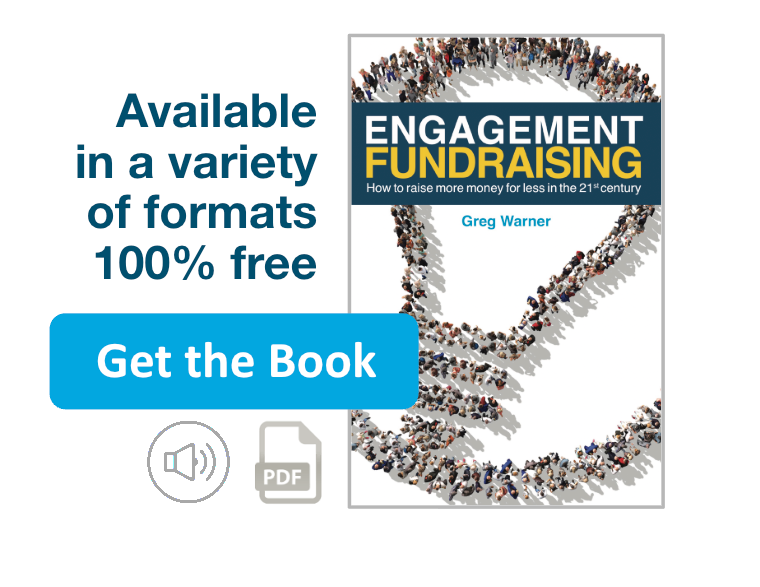Fundraising is story world
Lab experiments, field experiments, and academic theory agree: Fundraising lives in “story world,” not “commerce world.” Social-emotional story is the engine that drives giving. The technicalities, logic, and math of commerce world can’t do this. Those issues are still relevant. They can confirm or reject the giving desire. But they won’t motivate a gift. Motivation comes from story world, not commerce world.
This is key for understanding the power of gift restrictions. A restriction means the donor earmarks money for a particular use. Of course, “restriction” is a negative term. When a donor gets to put instructions with money, it’s “restricted.” When a charity manager gets to issue the instructions, it’s “unrestricted.” In both cases, money follows instructions. The only difference is whose instructions control the money.
Gift restrictions as story
Gift restrictions can be powerful for story. A story is about character and plot.
Gift restrictions can improve character. They make the donor’s character more important. They put the donor in control. A donor might even choose to use the gift “where needed most.” But the donor still chooses. Making the donor’s character more important works. It makes the story more compelling to the donor.
Gift restrictions can also improve plot. Plot requires change. A compelling story promises an emotionally relevant change. A compelling donation request does the same. If the gift doesn’t change anything, why make it? A gift restriction can help. It can connect the gift with a specific tangible outcome. It can evoke a clear image of an emotionally relevant change. It can turn a donation request into a donation story.
Fundraising is story world: The power of un-restrictions
Story world and commerce world are different. This can create some odd results. In a field experiment, one appeal letter had a restricted-gift option. Another version removed this option. The first version raised approximately $40,000 more.[1] No surprise. But here is where things got weird. About 98% of gifts for the first version were unrestricted. The restricted gift option increased giving. It did so even though donors didn’t use it.
Another experiment found the same thing. The researchers explained, “Allowing the option to restrict a charitable gift increases the average gift size, whether or not the donor chooses to exercise that option.”[2]
A similar result came up in another study. Allowing restrictions increased donations. It did so even for donors directing their gift “where it is most needed.”[3] Why did this work? Further questioning gave the answer.
Allowing restrictions evoked a clear image. It increased “the vividness of the mental pictures of one’s donation’s usage.”[4]
It increased agreement with statements like:
- “It was easy for me to imagine how my donation would be used,”
- “I had a vivid mental picture about how my donation would be used,”
- “It was easy to envision what would happen to my donation,” and
- “I could visualize how my donation would be used.”[5]
Allowing restrictions did something else. It increased donors’ sense of control over their gifts’ impact.[6] This feeling of control increased giving. But the feeling of control was just as high whether or not they chose to restrict.[7] Their gift may have gone “where it was most needed.” But it went there because they chose for it to do so. The gift was unrestricted. But only because the donor decided it should be.
Fundraising is story world: The donor character in control
In commerce world, the power of an un-selected restriction makes no sense. Donors didn’t choose the restriction. They didn’t want it. So, logically, offering it shouldn’t matter.
But in story world, it does make sense. A donor who gets to choose, plays a more important story role. The donor is in control. The donor makes it happen. This is true even when the donor chooses “where needed most.” Allowing restrictions works because it increases the feeling of donor control. This feeling, in turn, increases donations.[8]
Increasing a donor’s sense of control is powerful. This can show up in some strange ways. In one experiment, potential donors completed a form.[9] Some first chose between a blue or black pen. Others were just given a pen. Those who got to choose their pen donated more.
In another experiment, potential donors first completed a survey. Some chose its format.[10] They could pick either four or twelve questions per page. Those who got to pick the format then donated more.
Why did these small changes work? They gave potential donors a greater sense of control. This feeling of control, in turn, increased donations.[11] Giving donors control is powerful, even if it’s just a feeling.
A charity can choose not to offer restrictions. Or a donor can choose not to use the offered restrictions. In accounting, these two results are the same. But in story, the results are different. The plot is different. The character roles are different. Thus, donations are different.
Commerce world: Restrictions hurt impact
Gift restrictions can be great for story world. But they can be a problem for commerce world. Charity managers don’t like them. They use a negative word, “restrictions,” instead of just “instructions.” To them, such gifts are annoying. They can think, “The novice-donor is trying to take control from the expert-manager. It’s silly. It’s counterproductive. It’s wrong.”
This is a reasonable argument. But it doesn’t work for fundraising. Consider this. What if a family member responded like a typical charity manager? It might sound like this:
“Thanks for the tuition gift, Grandma. But I would prefer to spend it ‘where needed most.’ I’m sure your goal is my happiness. And, let’s face it, I know a lot more than you do about that. You should really leave it to the expert. Just give me the cash.”
That talk probably wouldn’t end well. According to economic theory, the grandchild’s argument is correct. So is the charity manager’s argument. The arguments might be true. But they still don’t work.
Story world: Restrictions help impact
For a donor, putting instructions with a gift is not negative. It’s intended to increase the gift’s impact. Experimental research supports this. Restrictions are most attractive to donors focused on their gift’s impact.[12]
Restrictions are even more important if recipients are seen as less responsible. In experiments, this is true for gifts to other people[13] or charities.[14] Consider an irresponsible family member. You wouldn’t want to just give them free cash. They might use it foolishly. Instead, you want to pay for something specific. The same idea applies to charities.
In one experiment, donors could give to a charity.[15] For some, the charity spent 15% on overhead.[16] It had a four-star Charity Navigator rating. For others, the charity spent 75% on overhead with a one-star rating.[17] Offering gift restrictions increased giving more for the second charity than the first.[18] In fact, once restrictions were allowed, giving was the same for both charities.
Donors didn’t mind giving to a high-overhead charity. They just didn’t want their money used for overhead. People don’t mind giving to an irresponsible family member. They just don’t want their money used for something foolish. In both cases, gift restrictions “fix” the problem. They fix the problem by telling a better story.
Peace between worlds: Gift restriction compromises
It’s true. Gift restrictions can be a source of conflict. Charity managers hate losing control. But putting donors in charge raises more money. Yet, this doesn’t have to be a zero-sum game. Often, both sides can be happy.
Donor instructions can be powerful. But they’re powerful as story. The world of story is not the same as the world of commerce. The same instructions can be powerful in story world, even if they make no difference in commerce world. This creates opportunities for effective compromise.
Two-world compromise: “Funged” restrictions
A gift restricted to an already-budgeted item acts like unrestricted money. Professor Wes Lindhall explains, “Some restricted gifts can be “funged” or transferred to other areas by budgeting differently.”[19]
Restricted gifts tend to pay for interesting things. They don’t usually pay for administrative expenses. But does this actually make a difference overall? A 2021 study of 7,031 charities found that, “Restricted revenues, however, do not curb nonprofits’ administrative expenses …”[20]
Restricted gifts don’t necessarily change anything. Other money can be moved to other expenses. Restrictions can end up being a meaningless accounting exercise. In commerce world, money is fungible.
But in story world, money is not fungible. My money is special. Restrictions can tell a better story about my money. My money makes a visualizable change. It wins a victory. Thus, my character becomes a more important part of the story.
Two-world compromise: Revenue restrictions

A similar result happens with a gift restricted to a revenue category. A scholarship gift to a university pays for tuition. But tuition is general revenue. Once paid, the tuition gift becomes unrestricted money. But because it was attached to a student, it’s now a story.
Or a donor might pay for others’ tickets to a charity’s cultural performance. This makes a great story. The recipients couldn’t have attended otherwise. But it’s also extra revenue for the charity. Once paid, the ticket gift becomes unrestricted money.
In both cases, the money started as a restricted gift. It ended as unrestricted revenue. The commerce world result is unrestricted money.[21] But the story world narrative is better.
Two-world compromise: Examples, not restrictions
Another compromise is to share examples of gift usage. Giving examples of what different gift amounts could pay for tells a story. It can evoke a clear image of a gift’s impact.
But examples aren’t restrictions. Examples don’t change commerce world. But they can make a difference in story world. For example, experienced fundraisers suggest, “Those solicited through direct mail, however, should receive multiple requests per year, each with a different theme … It’s a bit like restricted giving, but not exactly. Each theme is part of your core services.”[22]
Two-world compromise: Rating example uses
Providing restricted gift options can help in two ways.[23] First, options can create a social-emotional image. They can refer to specific outcomes. This makes the result more tangible. It makes the story more compelling.
Second, options require a decision. This makes the donor think. It requires thinking about and envisioning various outcomes. It increases the donor’s feeling of involvement and agency.
However, these feelings can be triggered without a gift restriction. A donor can be asked to rate the importance of different uses or projects. In experiments, doing this increases giving.[24] It works even when the gifts themselves are not restricted.
Sharing examples of gift usage is not a restriction. Asking for donor opinions on gift usage is not a restriction. Yet, these are powerful. They can capture the story elements that make restricted gifts attractive.
Two-world compromise: Combination restrictions
Donor restrictions can create a problem. Donors like to fund the attractive parts of an operation. But charities still need money for the other parts.
One compromise restricts only a share of the gift. For example, 2/3 goes to the selected project and 1/3 goes “where needed most.” Academic theory[25] and experimental research[26] support this approach. In one experiment, donors could restrict 2/3 of their gift to specific projects.[27] The rest went to projects of the charity’s choosing. This partial restriction worked just as well as a full restriction. The numbers changed, but the story remained.
Another version offers a combined project. For example, a new building is an attractive project. Maintenance, utilities, and insurance are not. A package can combine these together. The project might be a $30 million “permanent” building. Construction is $10 million. A $20 million endowment pays for $1 million annual maintenance, insurance, and utilities. This reframes the overhead costs. Now, they’re part of the new building project. They make the new building permanent.
This is similar to comprehensive campaigns. The campaign includes attractive new expenditures. These are combined with necessary, but less compelling, operational expenses. The gift is restricted. But it’s restricted to the combined campaign. This changes the dollars but keeps the attractive story.
Two-world compromise: Per diem restrictions
For some charities, compelling gift restrictions are obvious. A charity might build buildings, dig wells, or deliver physical items. But what about charities that offer only intangible services? What items could a donor buy for addiction recovery or crisis counseling?
One approach is the per diem story. A donor can pay to run a particular operation for a day, a week, or a year. Suppose a donor is interested in crisis counseling for battered women. The fundraiser could just pick an amount, such as, “Would you consider a gift of $6,000 to help this program?”
But the per diem request can be more powerful. For example, “The counseling operation costs $1,200 per day or $6,000 for a week. A gift sponsoring a week covers all of these costs. We recognize these donors at the entrance here. This helps remind our counselors and clients that others care about their success.[28] Sponsors receive a full report on all activities that take place during their week. For larger gifts, a full year is $300,000. A permanent named endowment for the entire program would be $6 million. You’ve mentioned how much this program means to you. You understand the impact it has in the community. Would you consider a gift of $6,000 to run this program for a week?”
This request is more powerful in several ways. First, it creates a reason for the amount requested. It also presents a range of amounts. (This can help if the request was too high or too low.) It introduces the concept of very large gifts. It creates a reason for large gifts. Each gift pays for a specific amount of work.[29] The largest gift adds the power of permanence. This is especially important for attracting large estate gifts.
A per diem request also does something else. It makes it easier to report the gift’s impact. Most charities already track operational activities. Often this is for an annual report. A gift’s impact report simply shows these for the sponsored time. Or, at least, it reports a prorated share of annual activities.
Bridging the two worlds
Fundraising lives in story world. In this world, gift restrictions are powerful. But they’re powerful as story. Effective fundraising story evokes a clear image that produces social emotion. When gift restrictions do this, they help. They help even if they don’t make a difference in commerce world.
Story world messages often don’t make sense in commerce world. Commerce world messages often fail in story world. Bridging both worlds is difficult, but it’s not impossible. It requires a translator. It requires a diplomat. In other words, it requires an effective fundraiser!
Footnotes:
[1] Eckel, C. C., Herberich, D. H., & Meer, J. (2017). A field experiment on directed giving at a public university. Journal of Behavioral and Experimental Economics, 66, 66-71.
Related Resources:
- The Fundraising Myth & Science Series, by Dr. Russell James
- 6 Things Your Donors Don’t Care About (That You Assumed They Did)
- 5 Reasons Why You Should Focus Your Fundraising On Foundations, Funds, Trusts, and Endowments




